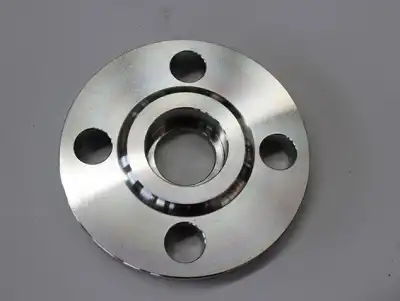What is the difference between a butt welding flange and a socket welding flange?
Butt-welding flange
Butt-welding flange, also known as butt-welding ring flange, is one of the most common flange connection methods. Butt-welding flanges are connected by connecting the flanges at both ends of the pipe and then connecting the flanges to the pipe in a butt-welding manner. Butt-welding flanges have a strong connection and good sealing performance and are widely used on piping systems with higher pressure and higher flow rates.
Butt-welding flanges are usually divided into three forms: common butt-welding flanges, long-weld neck butt-welding flanges, and flat butt-welding flanges. Ordinary butt-welding flanges are suitable for occasions under general pressure and temperature; long weld neck butt-welding flanges are suitable for occasions under high pressure and high temperature; flat butt-welding flanges are suitable for occasions under lower pressure and temperature, and they are generally used in water treatment and water pipeline systems.
Socket Welding Flange
Socket welding flange is a kind of flange connection, which is evolved on the based on of butt welding flange. Socket welding flange is first connected to the flange at one end of the pipe, then inserted into the end of another pipe, and finally butt-welded to form a new connection. Socket welding flange connection is simple, convenient, and suitable for small-diameter piping systems.
The forms of socket weld flanges generally include flat welding, projection welding, butt welding, and forging welding. Flat welding socket flanges are usually used for low-pressure, low-temperature occasions, such as water supply, drainage, etc.; convex welding socket flanges are mainly used for high-pressure pipeline systems in the fields of chemical industry, petroleum, electric power, etc.; butt-welding socket flanges are a commonly used form of socket weld flanges; forging weld socket flanges are suitable for high-pressure, high-temperature, highly corrosive occasions in pipeline systems.

What are the characteristics of socket flanges compared with other flanges?
Socket flanges have their unique characteristics among the flange types. Compared with other flanges, the design of socket flanges focuses more on convenience and sealing.
First of all, socket flanges are relatively easy to install and dismantle. Its unique socket structure eliminates the need for complicated bolting when connecting the flanges, which greatly saves installation time and labor. In addition, due to its simple structure, socket flange is also more suitable for use in some occasions where space is limited or it is difficult to use conventional flanges.
Secondly, the sealing performance of socket flanges is also very good. The socket structure can form an effective sealing barrier to prevent media leakage. This is especially important in high-pressure or high-temperature working environments, which can ensure the safe and stable operation of the equipment.
In addition, the socket flange also has good corrosion resistance and high-temperature resistance and can adapt to a variety of harsh working environments. Its materials are diverse and can be selected according to different media and temperature requirements to meet the needs of different projects.











